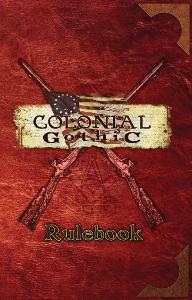
Product Name: Colonial Gothic
Publisher: Rogue Games
Author: Richard Iorio II, James Maliszewski
System: 12°
Setting: Colonial Gothic
Theme: Alternate History, Colonial America, Horror, Low Fantasy
Type: Core
Link: http://www.rogue-games.net/
Colonial Gothic is an alternate history setting powered by Rogue Games’ 12° system and placed within the backdrop of the American colonial period. The historical aspect of this setting is mired in supernatural and magical superstitions with inherently paranoid inhabitants. Colonial Gothic turns all of these superstitions and beliefs into a reality thus creating a surreal setting filled with the legends and fictional writings of the time or pertaining to the time.
These writings are turned into the horror found throughout the setting, along with a few Lovecraftian themes thrown in for added flavor. This period of time is already rich with history and filled with significant events that campaigns and adventures almost write themselves. Add to this a rules system that makes combat brutal, role-playing interesting, and covers lots of ground without worrying about the little things that can slow down a more convoluted system.
Just imagine running through town looking for George Washington while hunting a vicious vampire just outside the city limits. Will you change society or will you help save the day?
A PRIMER
The opening chapter for Colonial Gothic is a high-level overview of the system and the setting. It starts by giving a brief introduction to what the Colonial Gothic setting is about from a player’s perspective and from a GMs perspective. It’s a good introductory to the setting and gives a rudimentary feel for what this period in time, even with the alternate theories, is all about.
The chapter then moves on to introducing players and GMs to the 12° game system. This is a somewhat full explanation of the overall system while interjecting more detail on particular items in later chapters. I’m split on my feelings toward the 12° game system as it has it’s definite positive’s and it’s definite negatives.
The 12° game system is a 2d12 roll-under system where the target number (TN) is determined by the characters’ own abilities and skills. The dice rolled never changes while the TN changes depending upon the characters skill and ability levels along with any applicable modifiers. This is one of the best parts of the system as a characters ability to perform certain tasks becomes easier and easier as they progressively improve their abilities and skills. The TN is not dependent upon an opposing character except during opposing rolls. I like this system as your player character actually feels as though they are becoming more skilled as they gain experience.
HERO CREATION
The book next moves into Hero Creation, this is the section where I found a lot of confusion. All game mechanics pertaining to Hero Creation including abilities, skills, feats, backgrounds, etc… are explained in this section while further detail is provided in later chapters. I often found myself flipping back and forth to properly understand these mechanics or re-reading entire sections multiple times due to the confusion I was having.

To start, there are a number of times within this chapter, the Primer, and subsequent chapters that have conflicting information. Mechanics are presented in one way and then explained later in a slightly different way or with small changes. I found this very confusing and wondering what is the correct description and which one contains either a misprint, error, or different way of presenting the material.
To add to my confusion, the system uses terminology that is not common to most other published systems. While this is not a problem in any way, it should be better defined to eliminate any confusion that may result. Once again I found myself going back-and-forth between pages to read the mechanics again for proper understanding.
With these items of note out of the way, there are some interesting mechanics introduced here but further explained later. These include Resolve, Sanity, Fate Cards, and Faith Points; although I will discuss them in more detail in the chapters they appear.
The bulk of this chapter involves descriptions and explanations of the different backgrounds found within Colonial Gothic. This is the best part of the chapter as it introduces the different character “types” (not specific types but rather general archetypes) that are most commonly found during the colonial period of America. There are 9 archetypes introduced this way ranging from colonists, to military, to the Native Americans. I love the options and how each includes a brief background giving the players and GMs a “look and feel” for each standard archetype.
The chapter then moves into purchasing skills for your character. I struggled reading through this section, and ended up reading it about a dozen times. I’m not sure if it’s the way it’s presented or the mechanic itself, but I was very confused. When I read the later chapters concerning Skills, much of that confusion went away but did not leave me with a warm feeling concerning choosing skills. To me, this mechanic is slightly broken in that some people can badly abuse the way the mechanic is written. The mechanic itself is decent and well-thought out, but I can see players abusing it so that they are easily maximizing their characters in a way that is not conducive to role-play because the character is almost “too good”.
The chapter finishes out by fleshing out a few more details concerning the characters in a fairly standard format. I would like to see more in-game effects on these last details, but it’s not necessary.
SKILLS & FATE CARDS
This chapter fully details the skills used throughout the game, how skill tests are performed, and all the in-game effects. Degrees of success determine how the dice roll plays out during a standard skill test and opposed skill test. I like the mechanic of determining how well you roll against your opponents roll effects the outcome of the task being performed. Instead of simply denying the opponent their attempted task, the degree of success becomes a modifier to the opponents roll. If character performing the task rolls very well, they still have the opportunity to succeed in their skill test. This means that a player (or GM) will not be denied an action when they rolled extremely well. This plays in well to the “cinematic” feel Rogue Games states Colonial Gothic exhibits.
Colonial Gothic prevents from becoming bloated with too many skills by reducing the number of skills needed to perform standard tasks. This creates a smoother game flow and keeps games from being bogged down by too many decisions on what skill to use to perform their task. However, this section may be easier to read by using a two-column format for the skill listings. One thing to note is that while the list of skills avoids becoming convoluted, it still contains a wealth of options available for the different types of characters available. Skills like Divination, Language, Profession, and Study contain a great number of options to further detail a characters specific abilities.
The chapter then continues with the full explanation on Fate Cards and Faith Points. Within a horror setting, these can be crucial components that can either save your heroes or swing a storyline in your favor. This is a truly great way to make game-play more interactive by giving players some power to drive the storyline. Fate Cards are created by creating single statements concerning your characters background that may have some type of in-game effect. These Fate Cards can be used to further the storyline or change it slightly in the character’s favor. Along with Fate Cards, players are given Faith Points that can be used to save your player character in the manner of improving a skill test.
The way skills and Fate Cards are detailed and utilized, it helps to overcome the initial stumble point during Hero creation.
CURRENCY, WEAPONS, & EQUIPMENT
Colonial Gothic has an inherent difficulty within the colonial America setting, which it handles wonderfully. During this period in history, there was no established currency within the colonies and a number of currencies were present. Colonial Gothic gives four different options on how to handle this. From the most simple use of sticking to a single currency to involving an extensive method of currency conversion. This creates a huge amount of options for players and GMs to make their campaign as simple or as historically accurate as possible. It’s often difficult enough to recreate an historic setting, let alone one with such a complicated monetary system. Rogue Games has considered all this and fully detailed the options available including the conversion rates.
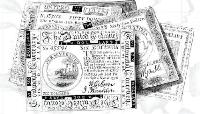
The chapter then moves on to the weapons and equipment available. The list is quite extensive and exhibits the items I would deem as made for the setting. However, the listing itself has a slight flaw in that there are a few attributes noted that are not explained. I found myself again confused until I read subsequent chapters where these attributes were thus explained. I would consider this more of a minor annoyance as the number of options made the list very useful, especially the equipment listing. Rogue Games has thought of almost anything possible when it comes to equipment. From clothes, to food, tools, and other mundane items, this book has it all. Upon finishing through the list of weapons and equipment, there is a good explanation of each type and their corresponding in-game effects.
ACTIONS
Actions are the bread-and-butter of combat. Some systems limit the possible number of actions while Colonial Gothic allows a player and GM to perform any number of actions but with a multi-action penalty. This is one of my favored methods of performing combat actions as it doesn’t hinder the cinematic feel or limit the player on what is possible during each round. Combat is further detailed with the possible bonuses and penalties for this like environment, cover, and movement. These are fairly standard and coincide well with the already described mechanics.
How well you roll under that TN is referred to as the degree of success. This number is used in a number of different ways throughout the game mechanics, some of them I agree with and some of them I don’t. The biggest one I have a hard time with is that this number is used as a multiplier to determine the level of damage caused by weapons. At times it seems a bit drastic for the possible amount of damage possible within this particular setting. Other mechanics use this number as a way of determining how well a character opposes an oncoming attack using reactions such as Dodge, Parry, and Block. These are good mechanics, but while having their drawbacks, the overall implementation feels properly done; especially considering that combat is meant to be ruthless in a horror setting.
The following major action style involves Social Interaction and the use of the Resolve ability. Considering the setting and how social interaction affects person-to-person relationships, this is a great method of creating a realistic feeling. The level of Resolve one character feels for another goes up and down depending on the different skills a character uses during the social interaction. This may allow or prevent the character from getting what they want or achieving the goal they are trying to achieve. The idea of rolling instead of role-playing to determine the results of social interaction may not be favorable for all players or GMs. To consider this factor, the rule for Social Interaction is completely separate from the overall game mechanics interacting with one another and can thus be removed with no in-game affect. This idea of a modular mechanic makes it that more valuable as it gives more game-play and campaign/adventure options.
Continuing the chapter are the rules for Fear and Sanity. These are staples in any horror setting and are presented similar to other systems. Although I did find conflicting statements on how Sanity is explained in regards to magic within this chapter and within the Magical Arts chapter, it is still easy to understand and ultimately fits in perfectly with the setting. Contained with this section is also an extensive list of disorders as a result of Fear and losing your Sanity that could be expanded upon but is still complete.
THE MAGICAL ARTS
Colonial Gothic is not High Fantasy, magic does not flow freely everywhere you turn. As such, magic can be helpful, powerful, and corrupting. One cannot live a life as a sorcerer without becoming corrupted by the powers they are tapping into. There are two types of spells that can be cast: Common and Arcane. Common spells are the simple, often-found, mundane sort of spells that can be helpful to all or the current task at hand. Arcane spells can be devastating, powerful, and cause penalties to be induced onto your opponent(s). There is a Third type of magic that is not spell focused in the form of Alchemy. Alchemy can be either helpful to your team or a hindrance to an opponent. While the setup is different, the implementation is similar to that of Common and Arcane spells.
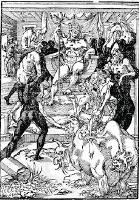
Spells are not simply learned but rather require research, proper ingredients, and preparation time before being attempted. This doesn’t follow the standard “cinematic” feel, but it takes magic to a different level of difficulty which is how it’s meant to be within the setting. There are details concerning how to perform these tasks including a list of possible ingredients one can use. Magic is made even more difficult for a player character with the given cost to learn/research a new spell. Spells are acquired by spending skill points but at a higher cost as standard skills. This is another great representation of how esoteric the arts of magic can really be.
Each spell found within this core rulebook contain a full explanation including history, in-game affects, and cinematic appeal. The list is fairly decent and can easily be expanded upon. However, the core mechanics of how magic works should always be maintained with the concept that magic corrupts and shouldn’t be taken lightly.
PLAYER’S GUIDE
The Player’s Guide could be considered as an historical sourcebook for player’s (and GMs). This chapter details much of the original colonies of the time and throws in some fictional content periodically. This prevents the player from having to research the information themselves and outlines thoughts and ideas on how the surroundings and establishments may affect a characters demeanor. This ranges from religion, to education, government, and transportation.
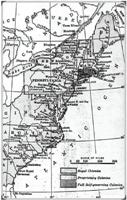
Being an already established historical setting, it’s hard enough for a player and GM to keep with the accuracy of where they are and how they interact with the rest of society. The Player’s Guide gives a good overview of the historical aspects of the setting along with some of the fictional implements creating the alternate history.
COLONIES & NATIVES
Colonies & Natives continues the sourcebook material already presented with a focus on the actual colonies themselves and the natives of the land. Each colony is well detailed including their history within this period, the major settlements, and adventure seeds. Most of this is material that a GM would be concerned with, but it helps to make the setting more three-dimensional from a player perspective. Regardless of how a player or GM uses this material, it truly enhances the content found within the book without by giving a great general outline of the historical aspects of the setting.
The chapter continues with a long list of Native American groups that were present during this time. These are the groups that interacted directly with the colonies either in a positive or negative way. Each one is well detailed including some historical facts and information that can be turned into plot-points.
GAME MASTER ADVICE
The Game Master Advice chapter is just that, an assortment of tips and suggestions for the GM on how to run an adventure or campaign. It includes details on how the Colonial Gothic setting is designed to “feel” with suggestions on how to make game-play more interesting. It then follows-up with details on how the historical aspects of the setting could potentially be used within game-play, whether it be a major part or just a back-drop.
This chapter continues with ideas and suggestions about creating villains or simple adversaries, including a very valuable list of how to rank these adversaries and villains to determine if the heroic party will be able to survive. Finishing up the chapter are tips on running a horror setting, bringing the heroes together as a proper team, and awarding experience. These are a great set of tips and tactics for a new or veteran GM especially once that is not familiar with running a game within an alternate history horror setting.
CAMPAIGNS
The Campaigns chapter is a short reference containing campaign seeds using real historic events. These events are well detailed and plot-points can easily be extracted from the information. Again, this chapter is not necessary, but enhances the content quality of the book and the source material presented within.
MUNDANE THREATS
I won’t go into too much detail as this chapter details the simple adversaries and NPCs that could be found throughout any adventure or campaign. Most of this is fairly standard, considering the setting, but is presented very well including a brief but beneficial description. While this content could benefit from more illustrations, it doesn’t detract from the quality of the publication.
MONSTERS
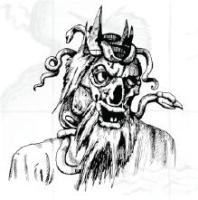
Similar to the Mundane Threats chapter but contain the fantastical creatures, horrific monsters, and the undead. As a precursor to this listing, there is a large number of options presented for creating your own unique monsters. This is something often not found within rulebooks and makes it easier for GMs to create their own monsters.
ADDITIONAL CONTENT
There is a story that plays out periodically throughout the entire book. This story is in the form of letters written between two individuals and a narrative of their interaction. While the story is well written, I struggled to understand how it directly correlates to the setting. By the time I finished reading through the book, I realized that the story is meant to present you with an idea for plot-points, an adventure, or a possible storyline to a campaign. The way it’s presented is much like reading a novel and extracting the details to create your own adventure while leaving the minor (and sometimes major) details to the reader themselves. This is a great way of presenting you with a possible adventure or simply presenting you with more source material.
The book does not contain an index, but it does contain a very extensive Table of Contents. While this is good, the book could benefit from an index that states every page in which a particular item of interest can be found. However, I did not find it difficult to go back and reference a particular piece of information I was looking for by using the Table of Contents.
The book wraps up with two very valuable references: a Timeline and a Bibliography. The timeline lists major events that happened throughout this period and can be easily translated into ideas for adventures and campaigns. Take these ideas and thumb through the bibliography to find a number of books concerning this period in history thus giving the GM more source material without having to spend time figuring out what books are out there.
OVERALL
With an historical setting that was mired in superstition, supernatural paranoia, and vivid fictional writing, Colonial Gothic does a fantastic job of giving that surreal feeling of horror within the dangerous New World. Game-play can range from cinematic combat to interesting role-play with mechanics that are very intuitive to giving players the true feel of the setting, while keeping things from becoming mundane. Even with the the noted confusions during Hero creation, once game-play begins, things should move swiftly and keep players involved.
RATINGS
Publication Quality: 8 out of 10
While the included content and illustrations do an excellent job of creating the setting, the multiple locations for defining the mechanics and their conflicting explanations can make reading through the book a bit difficult and slow to start. Once you get past that, the presentation flows smoothly and is filled with valuable source material.
Mechanics: 7 out of 10
The Character Creation mechanics are sometimes confusing and lend themselves to a bit of abuse. This can possibly be resolved through better explanations, more use of examples, and a better definition of terminology used throughout. The overall game mechanics, however, are fantastic and very fitting for a horror-based setting, especially when set within the colonial era of America.
Desire to Play: 10 out of 10
The richness of the historical aspects of colonial America could easily make Colonial Gothic desirable to those interested in playing within an alternate history. The horror added to the historical setting create an environment that is highly conducive to a possible endless number of hours of diverse game-play and very dynamic campaign settings.
Overall: 8 out of 10
What makes Colonial Gothic so appealing is the setting and how it works with the given game mechanics. It keeps with the style of horror-style combat being brutal and unforgiven while keeping with the cinematic appeal many players desire. The simple 2d12 roll-under system can create faster game-play without having to remember a multitude of different roll-types using an endless combination of dice. I recommend Colonial Gothic for anyone looking to move away from the often typical Fantasy and Sci-Fi settings and place themselves within a history rich setting filled with possibilities.

